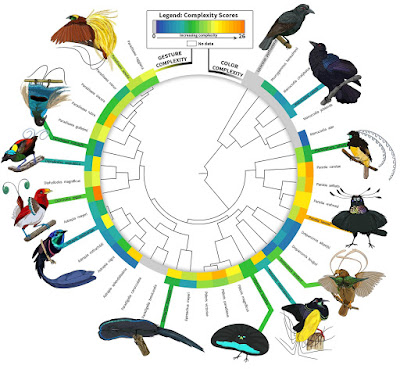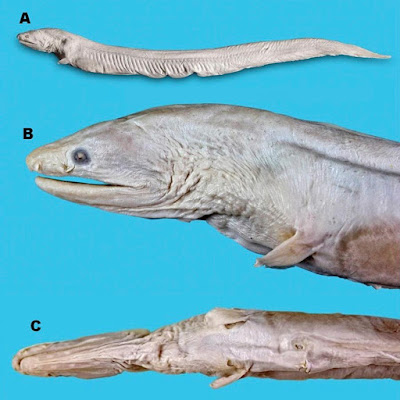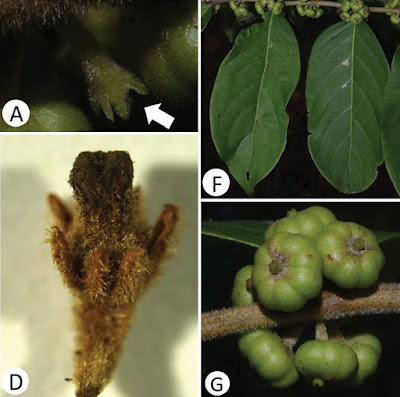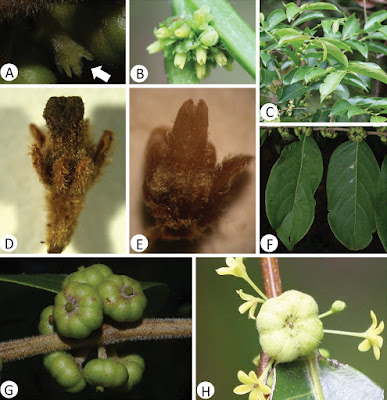[Most Recent Entries] [Calendar View]
Friday, April 13th, 2018
| Time | Event | ||||
| 8:32a | [Entomology • 2018] Revision of the Cicada Genus Dilobopyga (Hemiptera, Cicadidae) from Sulawesi and the Moluccas
Abstract This revision of the cicadas of the genus Dilobopyga provides a diagnosis of the genus and descriptions, illustrations and distribution maps for 48 species. The following 33 species described here are new to science: Dilobopyga angulata, angustata, bifida, curvispina, fasciata, hayashii, hollowayi, johani, knighti, langeraki, laterocurvata, latifascia, luwukensis, macrocerata, maleo, mamasa, mediolobata, nebulosa, operculata, palopoensis, pelengensis, platyacantha, quadrimaculata, rantemario, recurvata, rozendaali, sangihensis, sarasinorum, splendida, tambusisi, toraja, vantoli and watuwila. The key presented is designed for the identification of males of Dilobopyga to the species level. The subdivision of the genus in five species groups viz., opercularis group (17 species), nebulosa group (1 species), chlorogaster group (16 species), minahassae group (6 species) and watuwila group (8 species), is sustained by a phylogenetic analysis of morphological characters of all species described. The cicadas of the genus Dilobopyga are found in Sulawesi, neighbouring islands and southern Moluccas. Of the 48 species of Dilobopyga 43 species are endemic to Sulawesi. Most of these Sulawesi species are restricted to either one peninsula or to a part of Central Sulawesi. The remaining five species are endemic to either the Sangihe Islands, Banggai Islands or the southern Moluccas. A taxon-area cladogram for the species of Dilobopyga provides a basis for a discussion on the historic biogeography of the genus. Keywords: Hemiptera, taxonomy, Cosmopsaltriina, Dilobopyga, Identification, Key to species, Distribution, Areas of endemism, Historic biogeography J.P. Duffels. 2018. Revision of the Cicada Genus Dilobopyga (Hemiptera, Cicadidae) from Sulawesi and the Moluccas. Zootaxa. 4409(1); 1–172. DOI: 10.11646/zootaxa.4409.1.1 | ||||
| 8:48a | [Arachnida • 2018] Five New Cave-dwelling Species of Hemirrhagus Simon 1903 (Araneae, Theraphosidae, Theraphosinae), with Notes on the Generic Distribution and Novel Morphological Features
Abstract The suborder Mygalomorphae is generally poorly represented in the cave faunas of the world. The genus Hemirrhagus is endemic to Mexico and has 22 described species. It is the only one with epigean, troglophile and troglobitic species. Lack of urticating setae, loss of eye pigmentation and ocular reduction are interpreted as evolutionary reversals related to their troglobitic habits. From five troglobitic species in the genus, only the male of Hemirrhagus stygius is known. Five new troglobitic species are described with both sexes: Hemirrhagus akheronteus sp. nov., Hemirrhagus billsteelei sp. nov., Hemirrhaugus diablo sp. nov., Hemirrhagus kalebi sp. nov. and Hemirrhagus sprousei sp. nov. The female of Hemirrhagus chilango is described for the first time. Hemirrhagus akheronteus sp. nov. has a group of spinose setae on the opisthosoma; this setal modification was never reported in any other theraphosid spiders. Females of Hemirrhagus kalebi sp. nov. and Hemirrhagus sprousei sp. nov. lay fixed hammock egg sacs, which is an unusual behavior among species in Theraphosinae. Two stridulating setae previously reported only in epigean species are present on some of the new troglobites. Keywords: Araneae, taxonomy, cave dwelling, troglomorphisms, new species Jorge I. Mendoza and Oscar F. Francke. 2018. Five New Cave-dwelling Species of Hemirrhagus Simon 1903 (Araneae, Theraphosidae, Theraphosinae), with Notes on the Generic Distribution and Novel Morphological Features. Zootaxa. 4407(4); 451–482. DOI: 10.11646/zootaxa.4407.4.1 | ||||
| 9:30a | [Ornithology / Ecology • 2018] Synergistic Selection Regimens drive the Evolution of Display Complexity in Birds of Paradise
Abstract 1 .Integrated visual displays that combine gesture with colour are nearly ubiquitous in the animal world, where they are shaped by sexual selection for their role in courtship and competition. However, few studies assess how multiple selection regimens operate on different components of these complex phenotypes on a macroevolutionary scale. 2. Here, we study this issue by assessing how both sexual and ecological selection work together to influence visual display complexity in the birds of paradise. 3. We first find that sexual dichromatism is highest in lekking species, which undergo more intense sexual selection by female choice, than non‐lekking species. At the same time, species in which males directly compete with one another at communal display courts have more carotenoid‐based ornaments and fewer melanin ornaments. 4. Meanwhile, display habitat influences gestural complexity. Species that dance in the cluttered understorey have more complex dances than canopy‐displaying species. 5. Taken together, our results illustrate how distinct selection regimens each operate on individual elements comprising a complex display. This supports a modular model of display evolution, wherein the ultimate integrated display is the product of synergy between multiple factors that select for different types of phenotypic complexity. KEYWORD: Sanimal communication, behavioural ecology, display habitat, evolutionary ecology, lek, sexual selection, signal design CONCLUSIONS: Altogether, these results offer novel insight into the macroevolutionary pattern of visual display design: different signal components can be simultaneously and independently influenced by multiple core evolutionary processes, which interact to produce the ultimate integrated visual display. This highlights the remarkable potential of diverse selection regimens, often viewed as discrete operators, to instead function independently on a single signal component, while still interacting with other processes to shape overall complexity. The result is an integrated display that conveys more information than the sum of its constituent signals—and, in the case of extraordinary bird of paradise visual displays, exemplifies the diversifying potential of animal behaviour. Meredith C. Miles and Matthew J. Fuxjager. 2018. Synergistic Selection Regimens drive the Evolution of Display Complexity in Birds of Paradise. Journal Animal Ecology. DOI: 10.1111/1365-2656.12824 | ||||
| 2:36p | [Botany • 2018] Ophioglossum malviae • Discovery of the World’s Smallest Terrestrial Pteridophyte
Ophioglossum L. commonly known as “adder’s tongue fern”, has been of great interest due to the highest number of chromosomes in any organism so far known in biological world. Here, a new species of adder’s tongue fern has been discovered and reported from Western Ghats of India. It is prominently distinct from the other known taxa in Ophioglossaceae family. Phylogenetic analysis of three chloroplast DNA (cpDNA) regions (trnL-F, rbcL and psbA-trnH) unambiguously designate this adder’s tongue fern as the distinct lineage and is sister to the clade containing O. parvifolium and O. nudicaule. Azolla caroliniana – an aquatic fern (average size, 0.5–1.5 cm), is the smallest fern on the earth. Our discovery discloses a new species of adder’s tongue fern and ranking it among the smallest terrestrial fern in the world, attaining an average size of only 1–1.2 cm. ....
Taxonomy Ophioglossum malviae Mitesh Patel & Mandadi Narsimha Reddy sp. nov. Diagnosis: O. malviae sp. nov. is unique among species of this genus by its very small size and spike, spores with outer perine layer and unique type of stomata in which the marginal cells of lower epidermis form dome like papillae. Type locality: Jakhana village (altitude ~471 m), Dang district, Gujarat, Western Ghats, India. Etymology: This species is named after a lady Malvi Surti who inspire the first author for pursuing research in this field. Distribution and ecology: India – Gujarat state, Dang district, Jakhana village. The species grows in grassy area along with mosses on the grasslands of Jakhana village at an altitude of ~471 m, located in Ahwa forest division. Conservation status: Currently, about 12 plants of O. malviae sp. nov. were found in the type locality. However, this area is poorly explored for the Pteridophytes diversity. Therefore, an assumption that the other population might be distributed around this area and more further explorations are needed to determine its full range distribution, the species should be considered as data deficient for now. Mitesh Patel and Mandadi Narsimha Reddy. 2018. Discovery of the World’s Smallest Terrestrial Pteridophyte. Scientific Reports. 8, Article number: 5911. DOI: 10.1038/s41598-018-24135-2 | ||||
| 2:58p | [Ichthyology • 2018] Dysomma alticorpus • A New Species of Cutthroat Eel (Teleostei: Synaphobranchidae) from the Gulf of Aqaba, Red Sea
Abstract The cutthroat eel Dysomma alticorpus n. sp. is described based on a single specimen collected in a trammel net at a depth of 350 m off Eilat, Israel, Gulf of Aqaba, Red Sea. The new species belongs to the Dysomma anguillare species complex, which comprises species possessing a well-developed pectoral fin, intermaxillary teeth, a uniserial row of 7–15 large compound teeth in the lower jaw (which may be followed by a few smaller teeth), and an anteriorly situated anus with the trunk shorter than the head length. It is characterised by a combination of the following characters: origin of the dorsal fin well anterior to the base of the pectoral fin, predorsal length 13.8% TL; preanal length 22.8% TL; three compound teeth on the vomer; head pores: IO 4, SO 3; M 6; POP 0; AD 1, F 0, ST 0; lateral-line pores: predorsal 4, prepectoral 8, preanal 14, total 57–58, the last at the posterior two-thirds of the total length; MVF 7–16–115; total vertebrae 115. Dysomma alticorpus n. sp. is compared with other species of the genus. A revised key to the species of the genera Dysomma and Dysommina is provided. Keywords: Synaphobranchidae; Ichthyology; Systematics; Gulf of Aqaba; Red Sea; Cutthroat eel; New species Dysomma alticorpus new species Pale cutthroat eel Etymology: Altus (Latin) = high; corpus (Latin) = body. The name of the new species refers to the relatively high body of this new species. It is used as a noun in apposition. Ronald Fricke, Daniel Golani, Brenda Appelbaum-Golani, Uwe Zajonz. 2018. Dysomma alticorpus, A New Species of Cutthroat Eel from the Gulf of Aqaba, Red Sea (Teleostei: Synaphobranchidae) [Dysomma alticorpus, une nouvelle espèce d’anguille égorgée du golfe d’Aqaba, mer Rouge (Teleostei: Synaphobranchidae)] Comptes Rendus Biologies. 341(2); 111-119. DOI: 10.1016/j.crvi.2017.10.005 Résumé: L’anguille égorgée Dysomma alticorpus sp. nov. est décrite à partir d’un seul échantillon pêché au moyen de filets emmêlants à une profondeur de 350 m près d’Eilat, dans le golfe d’Aqaba (mer Rouge, Israël). La nouvelle espèce appartient aux espèces complexes de Dysomma anguillare, qui incluent des espèces avec des nageoires pectorales bien développées, des dents intermaxillaires, 7 à 15 grandes dents composées réparties sur un seul rang dans la mâchoire inférieure (qui peuvent être suivies par quelques autres moins grandes) et un anus situé antérieurement, un tronc plus court que la longueur de la tête. Elle se caractérise par une combinaison des caractères suivants : l’origine de la nageoire dorsale est bien antérieure à la base de la nageoire pectorale, la longueur prédorsale est égale à 13,8 % de la longueur totale, la longueur préanale est de 22,8 % de la longueur totale ; on relève trois dents composées au vomer ; les pores de la tête sont répartis comme suit : interorbital, 4, suborbital, 3 ; mandibulaire, 6 ; préoperculaire, 0 ; supratemporal, 0 ; les pores de la ligne latérale sont disposés comme suit : prédorsal, 4 ; prépectoral, 8 ; préanal, 14 ; au total 57–58 ; le dernier se trouve aux deux tiers postérieurs de la longueur totale ; la formule moyenne de la vertèbre est 7–16–115 ; le nombre total de vertèbres est de 115. Dysomma alticorpus sp. nov. est comparée à des espèces voisines. Une clé actualisée des genres des Dysomma et Dysommina est présentée. Mots clés: Synaphobranchidae; Ichtyologie; Systématique; Golfe d’Aqaba; Mer Rouge; Anguille égorgée; Nouvelle espèce | ||||
| 3:03p | [Botany • 2018] Glochidion shanense • A New Species from Myanmar [Taxonomic Studies of Glochidion (Phyllanthaceae) from the Indo-China Peninsula (I)]
Abstract Based on morphological studies performed on live plants in the field and specimens deposited in herbaria, a new species, Glochidion shanense Gang Yao & Shixiao Luo (Phyllantheae, Phyllanthaceae), is here described and illustrated. The species is morphologically most similar to G. ellipticum Wight, but can be distinguished from the latter by having hairy branchlets, longer pedicels, uniseriate and narrowly triangular sepals of female flowers, 4–5-locular ovaries, stout and cylindric persistent style on fruits. Keywords: Phyllanthaceae, Glochidion, Morphology, Myanmar
Glochidion shanense Gang Yao & Shixiao Luo, sp. nov. Diagnosis: The species is similar to G. ellipticum Wight in morphology, but differs from the latter by its branchlets pubescent, pedicels of female flowers 1.5–2 mm long, sepals of female flowers uniseriate and narrowly triangular, apex of style truncate slightly, persistent style of fruit stout and cylindric. .... Distribution and habitat: This new species is currently known only from its type locality, Shan State, eastern Myanmar, where it grows in the broadleaved and coniferous dry forest dominated by Docynia indica (Wall.) Decne., Schima wallichii (DC.) Korth. and Pinus species. Etymology: Glochidion shanense is named after its type locality, Shan State in eastern Myanmar. Gang Yao, Jie Cai, Youheng Wu, Xuefei Yang, Thaung Naing Oo, Aung Zaw Moe and Shixiao Luo. 2018. Taxonomic Studies of Glochidion (Phyllanthaceae) from the Indo-China Peninsula (I): G. shanense, A New Species from Myanmar. PhytoKeys. 96: 57-62. DOI: 10.3897/phytokeys.96.24497 |
| << Previous Day |
2018/04/13 [Calendar] |
Next Day >> |













